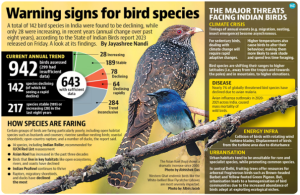Context:
According to a recently released State of India’s Birds (SoIB) report, based on data from about 30,000 birdwatchers, a large number of bird species in India are either currently declining or projected to decline in the long term.
Concerning Statistics:

- Out of the 942 bird species that were assessed, 142 are diminishing and only 28 are increasing.
- While raptors, migratory shorebirds, and ducks have declined the most, birds living in habitats like open ecosystems, rivers, and coasts are among the worst affected.
Key Factors responsible for the decline in Bird Species:
Climate Change:
- Catastrophic Consequences: The average global temperature has risen by over 1 degree Celsius since pre-industrial times, resulting in catastrophic consequences.
- Phenological Mismatches: Climate change affects bird reproduction and survival through the disruption of species interactions by phenological mismatches (it occurs when the timing of annual events like breeding, nesting and migration become out of sync).
- Mismatches in seasonal timing (of migration, breeding, emergence) between birds and their prey can reduce survival and reproduction and also lead to fatal competition with other species.
- Rapid Adaptation: Rising temperatures force sedentary birds to go through rapid adaptive changes. For instance, Amazonian birds over 50 years lost body weight to lose heat more efficiently.
- Behavior Change: Birds tend to spend more time looking for shade instead of searching for food.
- This can have an adverse effect on their survival and reproduction.
- Dangerous Interactions: Climate change leads to new and dangerous interactions between different species.
- In Hawaii, with rising mercury, mosquitoes have colonized higher altitudes, resulting in rise to malaria among mountain birds.
Urbanization:
- Inverse Relationship: The most urbanized regions in India have the least number of bird species, the least number of rare species, and the fewest insectivorous species.
- Loss of Habitat: Urbanization results in loss of natural habitat for birds and it exposes them to more air pollution and high temperatures.
- Noise pollution in cities forces birds to sing louder, or at different frequencies, or, in the worst case, to abandon otherwise suitable habitat.
- Collision: Light pollution confuses and disorientates them, resulting in colliding with buildings.
- Homogenisation of Bird Communities: It occurs due to lack of food supplies in urban areas.
- As only behaviourally dominant species such as House Crows and feral Rock Pigeons are able to survive.
Monocultures:
- The practice of growing one type of seed in a field at a time.
- In India, commercial monoculture plantations of rubber, coffee, and tea have been rapidly expanding in recent years.
- However, such plantations are detrimental to the well-being of birds. Commercial monocultures are known to harbor fewer bird species than natural forests within the same biome.
- Oil palm plantations in Mizoram support only 14% of the bird species found in comparable rainforests.
- In Uttarakhand, teak plantations can shelter just 50% of the total woodpecker species seen in the state’s sal forests.
Energy Infrastructure:
- Renewable Sources of Energy: These are emerging as a threat to birds.
- Various species are known to have been killed due to collisions with wind turbines.
- Several of them have migrated to regions where there aren’t such giant devices.
- Death due to Current: The transmission lines have also led to the death of many large-bodies species because of collision and numerous small-bodies species have been electrocuted.
- A literature review reveals that over 60 species from 33 families of birds are affected by collisions and electrocution at power lines in India.
The Path Ahead:
- Conservation: There is a need to conserve specific groups of birds.
- Systematic Monitoring: It is critical to understand small-scale changes in bird populations.
- More Research: It is necessary to understand the reasons behind the declines or increases and take any steps and prepare legislation.
- Involvement of Local Base: Conservation of bird species and habitats must include citizen participation.
- Awareness & Education: It’s high time to spread awareness and educate the common people of India about the importance and vulnerability of the birds & every species.
News Source: The Indian Express
![]() 28 Aug 2023
28 Aug 2023

